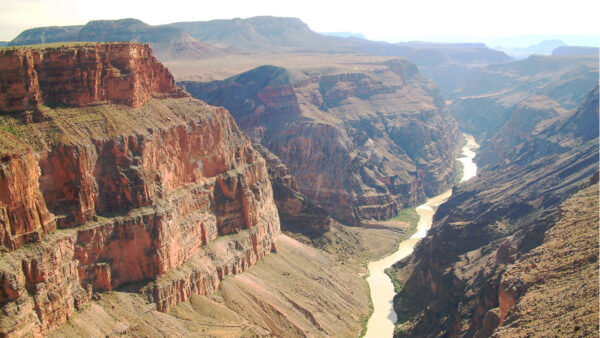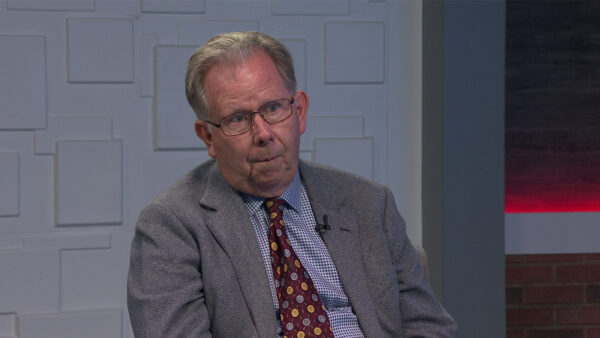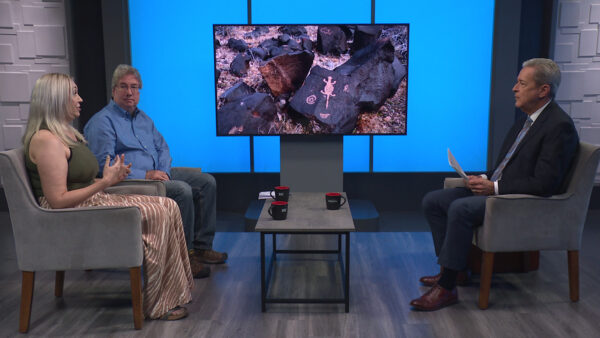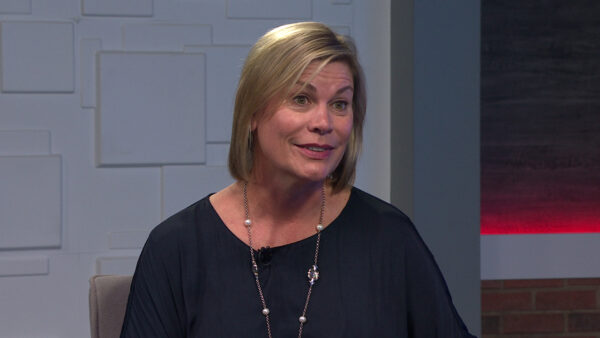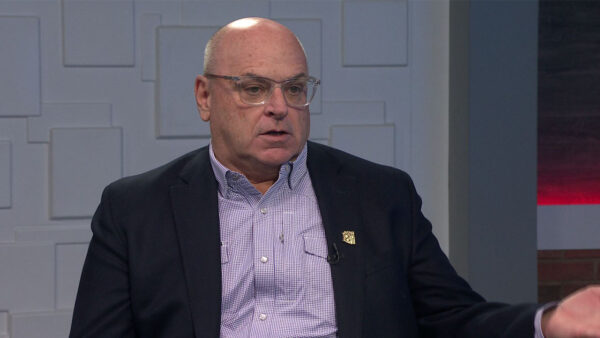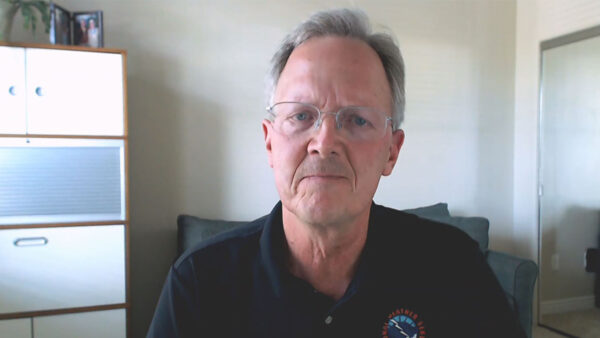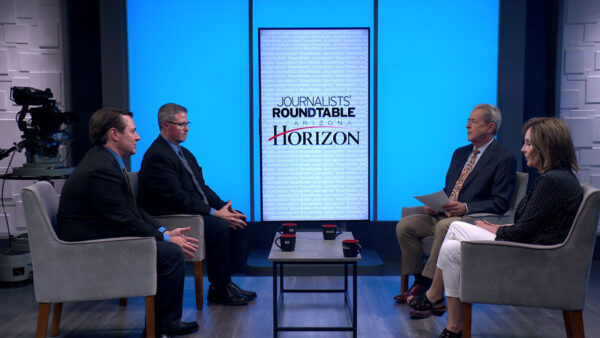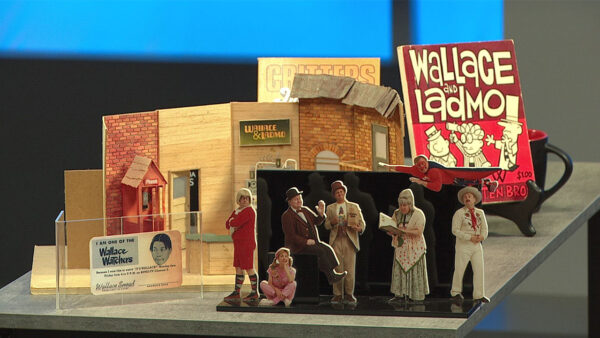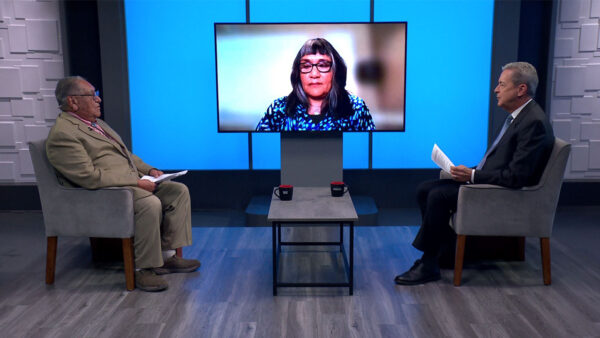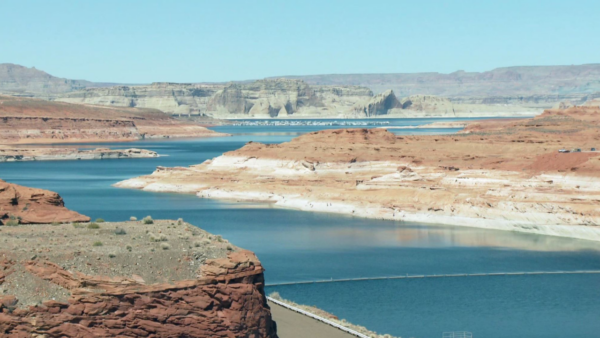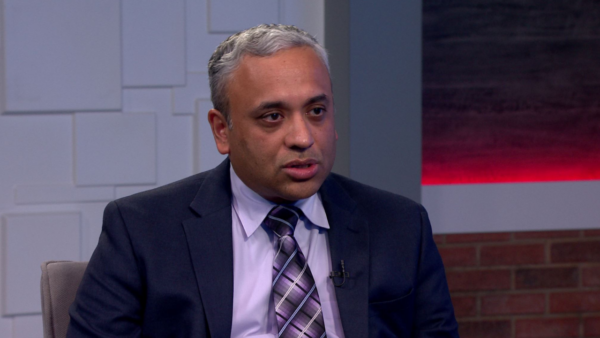Chandler artist Bruce Marion talks about his creative process and the inspiration for his paintings. He also comments on his recent experience introducing children to abstract art as an artist in residency at a local charter school.
Ted Simons: On tonight's "Arizona Artbeat" we look at the work of Chandler artist Bruce Marion. He'll be here in just a moment, but first photographer Scott Olson and producer David Majure take to us a Scottsdale school where Marion introduces kids to abstract art.
Bruce Marion: You think we'll bring some light in there.
David Majure: Bruce Marion enjoys teaching students a subject that has limitless possibilities.
Bruce Marion: With a painting, we could add a little color here, lighten this, this painting could go a million different ways. And I love that. There is no right answer. We're going to continue on -- you're going to work with Ms. Lee.
David Majure: Bruce and his wife worked as a team during a two-week artist in residency program at the PLC arts academy in Scottsdale.
Lee: Does that matter? No. No. It's just a guideline for us to help us get started. Does everyone have that?
David Majure: Using one of Bruce's paintings as an example, Leigh shows the second graders some fundamentals of blending shapes and colors.
Lee: That's great.
Bruce Marion: What's up, man? How's it going? Ready to do some painting?
David Majure: Meanwhile, Bruce works with the students one-on-one.
Bruce Marion: Let's see. What do we want to do?
David Majure: They're collaborating on a class project, and the abstract painting that every child has helped create.
Bruce Marion: Work it up off the template. There's something really beautiful happening in the moment, and that's how these are approached. These are not preplanned, but one step leads to the next, leads to the next, you step back and look at and it make some choices. I love that process. And I think the kids respond well to it. Good job. Good morning. What is that on your watch? Are you super excited?
David Majure: Bruce has fun introducing kids to abstract art.
Bruce Marion: You know, they seem pretty open to it. Because I think most of them don't know how to draw realistically or render, so I think it's more natural to them.
David Majure: On the other hand, he says grown-ups are less likely to get it.
Bruce Marion: Actually when I got out of art school I used to think anyone that did ash extract art didn't know how to draw or paint. So you become an abstract artist, but from being a realist and an illustrator, and moving into painting, I made a leap to go into abstract art, and I realized how difficult it actually is, because there's no subject matter to really lock it in. Like once it looks like a tree, OK, I'm done, I rendered it, it's a tree, but again, with abstract art it's so open, all you have is texture and shape and moving light through it, and you're playing with all the abstract elements.
David Majure: When kids have a chance to play with an empty canvas, they don't hesitate to fill it with ideas and endless possibilities.
Bruce Marion: For me I think my main goal is -- I know a lot of them won't be artists and there probably a few that L. but I like they're learning some skills out of it. Ultimately I think in any teaching it's just giving them the excitement about learning. I think if you have excitement about learning when you're out of school, you'll continue that process.
Ted Simons: Joining me now to talk about his painting and his work with kids is Chandler artist Bruce Marion. Good to have you here. Thanks for joining us.
Bruce Marion: Thanks. You're welcome. Thanks for having me.
Ted Simons: You are an artist, what does that mean? What do you do?
Bruce Marion: Well, I'm a lucky one. I get to paint pictures and make my living doing that, which is amazing. I'm thankful every day for that.
Ted Simons: When you paint, is it something that you see? Is it something -- abstract or maybe not so abstract, or is it something that you see?
Bruce Marion: It's interesting, I was an illustrator for a lot of years where I would look at things and illustrate and create realistic things. Most of the pieces I do now are a sense I have about something, I'll start with something, with abstraction on my canvas and I'll let the image emerge, and it may take different directions. I may start creating a river, and it's not working, it may move in a whole different way. So I have really learned to follow the process of painting without forcing it to be what I think it should be.
Ted Simons: So much in the way a novelist will say I started with my characters being one way but the characters decided to be something else. It's the same thing with painting something.
Bruce Marion: Exactly.
Ted Simons: I know as well, I thought this was fascinating, you start with an under painting so to speak, you start with almost a background in a sense, but like a sculpture, you then subtract from that and bring something -- how -- talk to us about that.
Bruce Marion: It's interesting, I studied classic art and the old masters would always start their painting with a medium tone, brown, umber or brown, and they would build their painting off that. But they'd get rid of the white. Like a writer staring at that white canvas is intimidating. So when I started playing with abstraction, I kind of developed this technique where I would do this wild abstract painting, very free form with all this energy, and paint moving around, and I'd fill the canvas, so I'd have color, and texture happening. So then I let that dry, and then to me it's a matter of -- so I've got this crazy universe going, then I start like a sculpture, chipping away, covering up parts of it with opaque layering until the imagery starts emerging out of it.
Ted Simons: And you never know what that going to be until you subtract?
Bruce Marion: Exactly. I'll usually base coat them not knowing what I'm going to paint.
Ted Simons: You use the same concept, I've read, and hope you tell us more, with the kids. As we saw, they're doing their thing, and something develops.
Bruce Marion: Exactly. The beauty with the kids, they listen -- each class listened to a different piece of music, some was more classical, one was a 2001 kind of piece, and out of that music we started talking about the emotions and feelings of that, and what colors did that feel like. Was it cool colors or warm and hot colors, so we decided on a palette then from there the kids -- they loved this part, they did the abstraction where I give them appellate knives and tubs of paint and they're going at it. It's actually quite beautiful in that state. So then that dried and we talked about what kind of shapes does this music feel like? Is it oval shape, jaggy shapes, and so they're kind of interpreting music into a visual form.
Ted Simons: And they understand what you're asking them to do.
Bruce Marion: I think so. The results speak for themselves. It's pretty neat.
Ted Simons: The idea of teaching kids the creative process, it can be such a dicey thing. You're dealing with kids, you're not sure -- talk to us about that, and this nonlinear way of thinking. How you're promoting that idea as opposed to two plus two always equaling four.
Bruce Marion: Exactly. As I've learned in my career, the first part of my life was very logical and if I do A, B, C, I'm going to get D. Logical brain. And the more I started letting go and listening to my intuition, and just looking at what's around me and responding to that, almost like the golf swing you're talking about, you've got to be in the moment doing it. You can't be thinking of your lesson, your practice. And I approach art that way. I'm right there with the canvas, and I'm going to see what's emerging out. Because there may a beautiful passage, but if it's not my initial plan, I would just cover it up. But by following the painting, I can allow that passage to become part of it, and I can see what beauty is coming out of it and be right there in the moment.
Ted Simons: When you're working with kids, are they easier -- I know you work with kids and adults, are kids more amenable to that sort of thing? Is it easier for them to get rid of that nonlinear thinking?
Bruce Marion: I'm not sure. I think kids are more open to it. I think as adults we get a little more locked in with our thoughts and what we think we can or can't do and what's acceptable or not. And I think adults too, myself included, we start getting very worried about outcome. Your art is like broadcasting is a very public sort of thing. I'm going create a painting to show to people. You don't want to do something that looks stupid, oh, this has to be my masterpiece. But as I tell my students, the minute you start thinking that way, you freeze up, when you think about oh, I gotta do the perfect shot, you've lost it already. You can't be thinking that.
Ted Simons: It's that little person on your shoulder who keeps saying, this isn't very good.
Bruce Marion: That too. Oh, yeah. We all have that one.
Ted Simons: You've got to brush them off and move forward. Do you notice a difference between teaching kids and adults in that sense of being open in that sense, just sake brush that critic off and go ahead no matter what?
Bruce Marion: I'd say the kids are much more free. When you give them paper -- my wife was working with them on small pieces, they would do some amazing things, not thinking about it, but intuitively, and I think as adults we get too analytical and too worried about how it's going to look and worried about the outcome. I think kids haven't been conditioned completely to that stage yet.
Ted Simons: You mentioned -- I saw on your website a couple of quotes. "You must be both a dreamer and a pragmatist." What does that mean?
Bruce Marion: That's a good question.
Ted Simons: That was long ago you must have said that?
Bruce Marion: I hardly ever remember what I say.
Ted Simons: Here's another one. "There has to be a duality of character and purpose when it comes to art." Does that make better sense?
Bruce Marion: I think with both of those, what it means to me is, I've got to show up and do the work every day so there's a pragmatic part to it. But I am such a dreamer, my -- I have enough ideas, if I lived to two or 300 years old I wouldn't have enough time to do all the ideas in my brain as far as explore with art. So I think the pragmatist has to pull it down and stay focused on what needs to be done and -- you always have to do the work. You can't wait for the inspiration. So you've got to show up for that.
Ted Simons: It's basically, guy back to the writing analogy, you have to sit down and write. Sit there and do it. You just can't wander around staring at the sky. Is that -- does the muse hit you or do you find the muse?
Bruce Marion: I find the muse. If I waited for inspiration, I would never have a career in this. It really is a matter of the discipline -- what I found, this is interesting. You start painting and then the inspiration comes. Sometimes you're inspired before, but mostly show up, start painting, and watch what happens, and your mind and creativity starts getting engaged and you're getting excited about something. So it really comes out of the work, where I think people misunderstand a lot of people wait for inspiration, or people who are learning, I'm not inspired, I'm not going to do anything yet.
Ted Simons: It's like that with a lot of life. You've got to just do it and if something happens, it does, if it doesn't, it doesn't. Your work with children is fantastic. I love the idea of teaching problem solving skills and such by the creative process. Congratulations, and thank you so much for joining us.
Bruce Marion: You're welcome. Thank you very much. Appreciate it.
today.
Bruce Marion:Chandler Artist;


